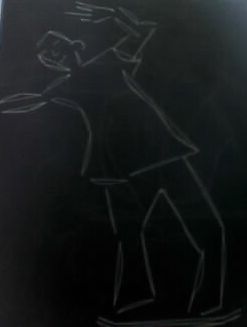Innovation
by Steve Lenhert
Original Dateline: 21 November 1999
"That's it for me, I swear. What else is there? The 900 was my goal." States the legendary Tony Hawk (ruler of Birdhouse after performing the first 900 in competition history.
The process of creating (or discovering) new tricks begins with a desire for a challenge. All skaters have an illusive trick, a gap that's a little too big, or a perilous handrail, that they can not seem to conquer. The first step in creating a new trick is the most difficult, overcoming these limitations and making your weaknesses your strengths. This principle is best illustrated by a story about an old friend of your guide:
Gabe Linn is now an innovative professional snowboarder. Long ago, before he began his snowboarding career, he was a skateboarder who seemed to be limited by the same laws of physics as the rest of us. However, he differed in his ability to try something that most people were scared of. One day he was skating and came upon a frighteningly steep six-stair handrail made of wood (which does not slide well.) He tried to slide it anyway, resulting in damage to his foot that put him in a cast for several months. After such an experience, many skaters would be hesitant to skate any handrails, let alone the same one. Gabe, however, was different. The day that the cast was removed, he went directly back to the same handrail to complete the maneuver. Complete it he did, breaking the other foot this time. Again, that might be a sign to most skaters to stick to some nice curbs, or at least easy handrails. Not Gabe though. He wouldn't let that handrail beat him. Once the other foot had healed, he went back and landed it. That handrail was the most difficult thing he could do at the time, and he did it. Now he has moved on to more perilous endeavors.
The next challenge will be to find out what has been done before, and a lot has been done. Once you conquer that trick, gap, or handrail you will no doubt see a video, magazine, or real skater who seems to have done the same trick. You may rediscover the pressure flip, ollie impossible, and no-comply only to find that they are very old tricks. Soon, a feeling that all this has been one before will begin to develop. Don't be discouraged by this because 1) it's not true, and 2) it's a sign that you're going in the right direction. Each person is different, and when you do a trick it is never the same as when someone else does it. For example, maybe when you slide a rail you instinctually tweak your board in a strange way that allows for the bigspin dismount.
Once you've developed the drive, and you are aware off the current state of the skateboard world, there are a couple of tricks that can be used to help create.
1. Going big - This is the method used by Tony Hawk when he spun 180 degrees more than ever before (in competition history.) Always ollie a little higher, slide a little longer, and skate a little harder than the last time.
2. Fusion - combining two (or more!) tricks is a great way to come up with a new one. This best illustrated by the m-air. An example of a new trick that was recently e-mailed to me involving the fusion of soap shoes and a vert ramp.
3. Mutations - Drawing from biochemistry, this means that sometimes when you wreck you might actually be discovering a new trick! For instance, many years ago before the onset of the late shove-it, some friends of mine were filming attempts at ollieing a garbage can. One guy bailed out in the air, unknowingly coming remarkable close to the first late shoveit. Nobody noticed it until a few years later when late shove-its became the rage. Pay attention to your crashes, and only repeat them if indeed they are useful.
By the way, Rodney Mullen is your guides pick for the most innovative skater of all time.
Contact Steve Lenhert - nanotech.guide@about.com





